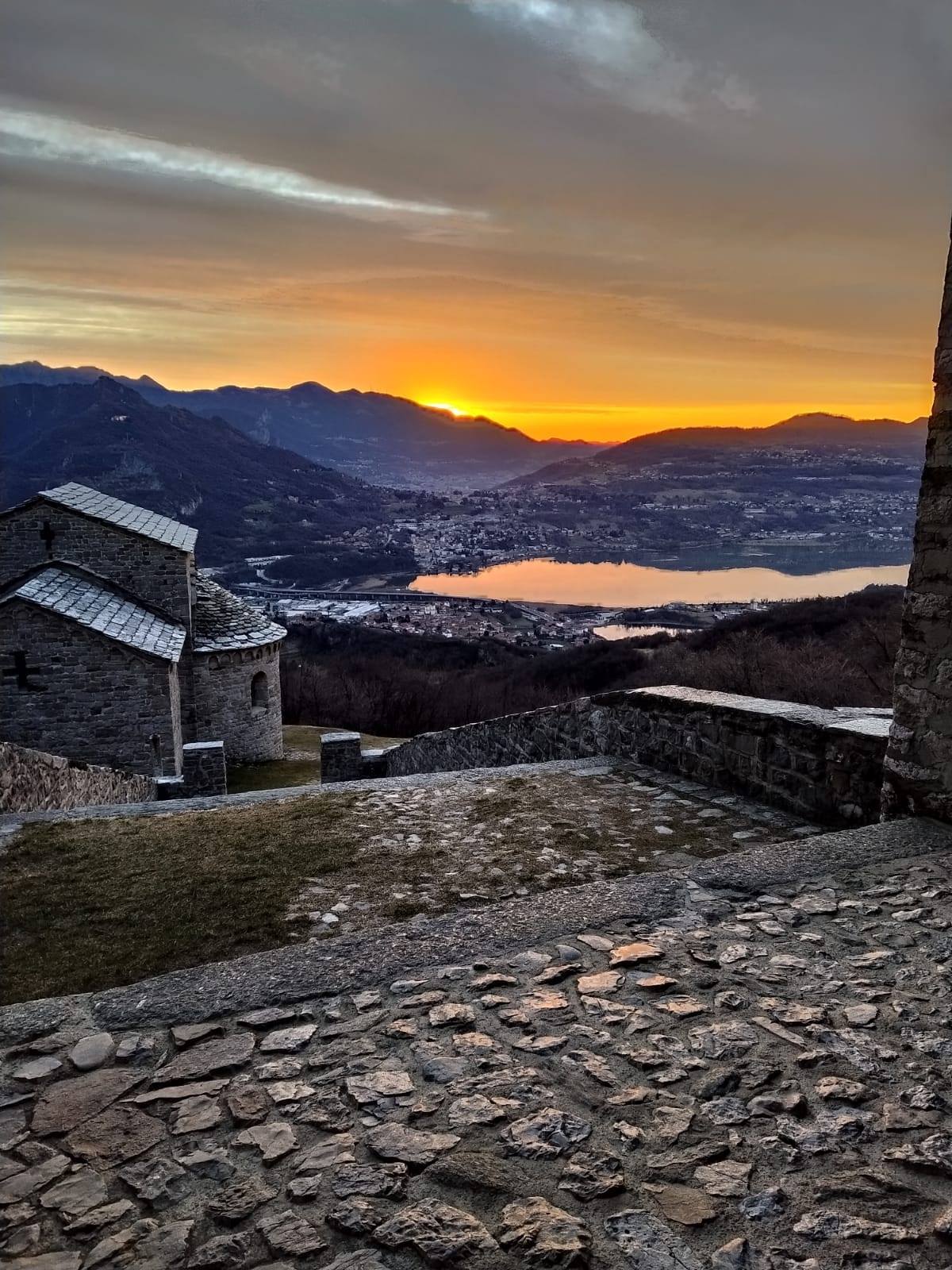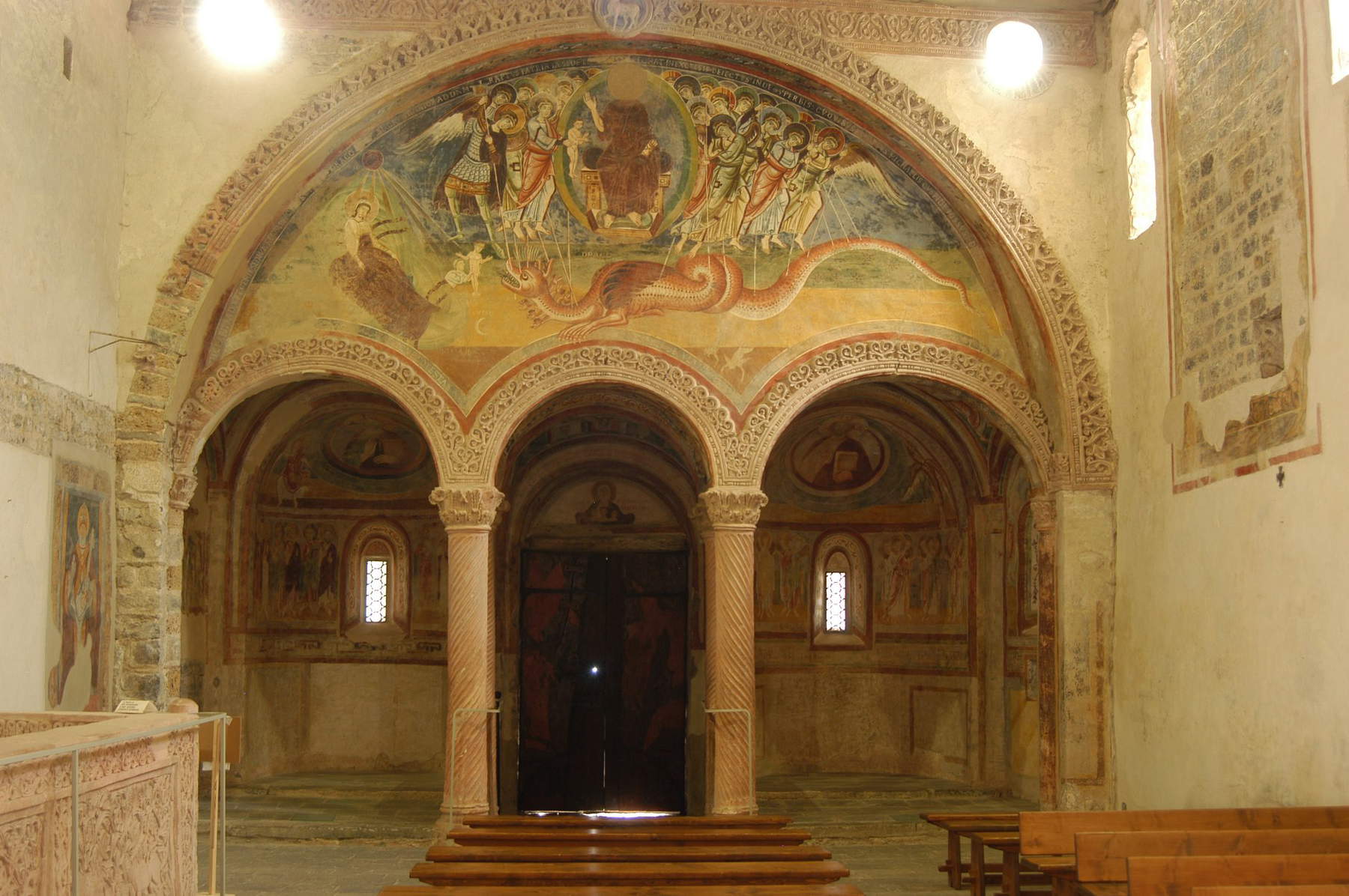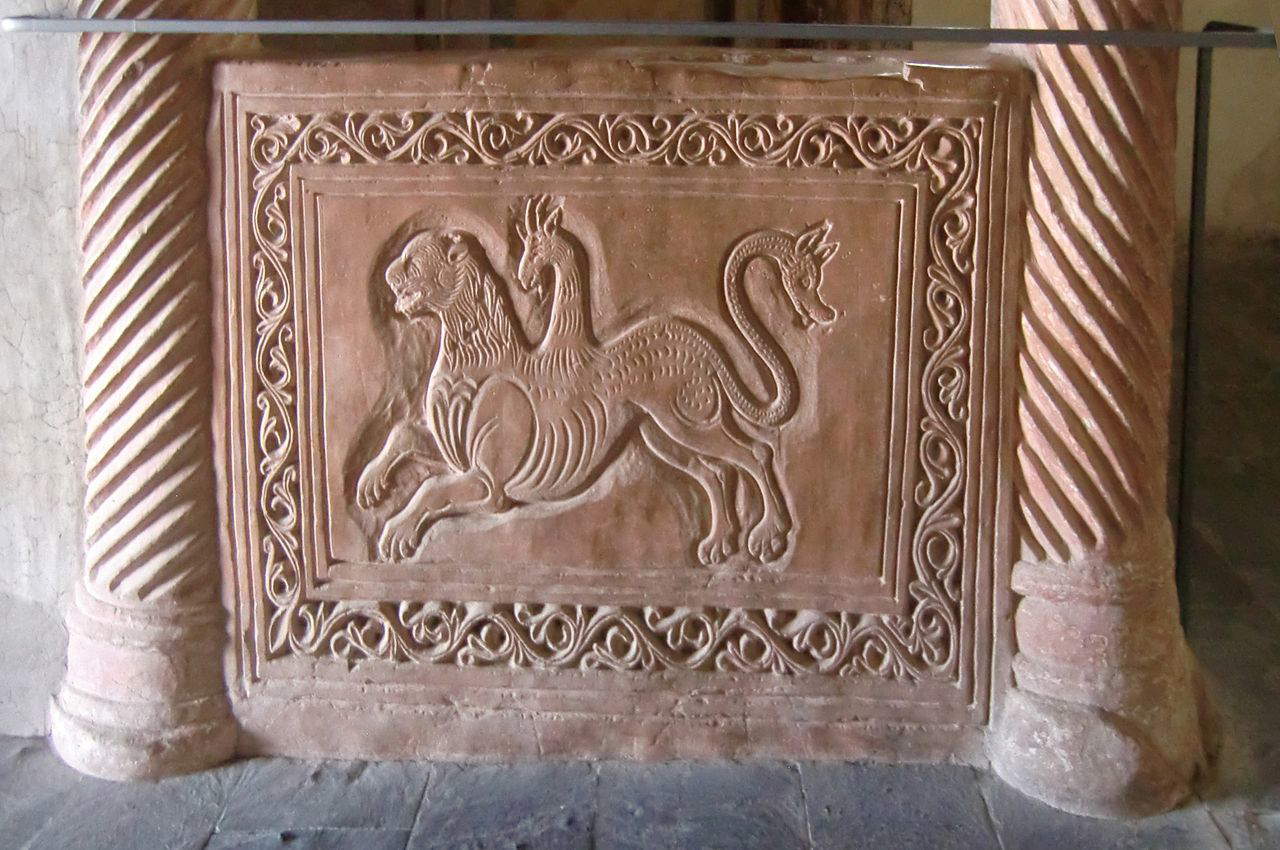1. Two. Three. Four. Thus begin, with one foot in front of the other, all discoveries in the mountains. They begin by counting the beats of one’s heart, the breaths, the steps that follow one another and the minutes or hours that have passed since one started. Who knows how many are really prepared, after a steep climb up a mule track of Lombard origin, to discover theabbey of San Pietro al Monte in Civate. It does not stand solitary on an inhospitable peak, but is perched rather low at 622 meters above sea level, embraced by forest and supported by massive gray dolomite in what is called the Golden Valley. One could return there countless times, at different times in one’s intricate existence, to discover with each ascent, with each step, something new that catches one’s eye.
As one walks and the earth slips unhurriedly from under one’s feet, one might seem to mistake the whistling of the wind, muffled by the centuries-old trees of the forest, for the sound of distant voices whispering legends such as that of the construction of the abbey itself. As narrated by the Milanese chronicler Galvano Fiamma, Adelchi, the son of the Lombard king Desiderius, fatigued by the difficult journey through the valley, lay down under the dense foliage of the forest trees to find refreshment. It was at that instant that he saw a very majestic white boar with sharp tusks, and the boy, moved by that typically youthful ardor, chased after it to kill it. The poor animal, as mighty as it was, found itself defenseless and ran away terrified before such ferocity, finding refuge under the altar of a small church that stood at the top of the mountain. When the king’s son found him, he drew his sword to take the defenseless beast’s life, and at that exact instant his world went completely dark. Adelchi became blind, and only Benedictine monks, by dropping water from a nearby spring on his eyes, were able to cure him. It was then that King Desiderius, moved by the miracle for which he had prayed so much, decided to build a larger church precisely where the boar took refuge to seek help.





The origin of the complex is lost in the legend to which it is closely entangled, but according to tradition San Pietro al Monte owes its foundation to the last decades of the Lombard reign. We can have solid certainties, however, only from the mid-9th century, when the archbishop of Milan Angilbert II had the relics of St. Calocero transported there from Albenga. For the abbey these were the years of its greatest splendor, amid the ever-increasing number of monks and flourishing cultural activity. The old tower and church chapels, of which nothing but timid traces remain today, were torn down, and the building was designed from the beginning with a single nave and uncovered truss roof, the ciborium recalling the forms of the Milanese one in the basilica of St. Ambrose, and two new apses. A document dated 845 tells of the presence of thirty-five Benedictine monks, while from the year 1000 the abbey of Civate began to experience a prosperous and fortunate period, not only becoming a protagonist in the tormented period when Milan was traversed by the Patarine heresy, but above all knowing fame through a revival of worship, passing in 1018 to the title of St. Calocero. It was during these years that the central core of the present abbey was most likely built, while in 1097 Archbishop Arnolfo III of Milan was buried there.
Today, climbing the high steps, one could be astonished and amazed at how every man-made place is shaped over time, adapting to the people who inhabit it: the double apse is due to later modifications. During the 10th century, in fact, the high stairs did not exist and one entered from what is now the apse, while the original one faced east, as was the norm, and thus looking toward the valley. Over the years, however, for practical rather than religious reasons, the monks decided to change the entrance by walling up the old facade, of which unfortunately no trace currently remains.
The present structure accommodates a seemingly bare room, but as soon as one crosses the threshold and turns one’s eyes behind one’s back, looking toward the vast semicircular pronaos, one will be able to discover a very special pictorial cycle. Here the eye is lost in following the textures of the fresco that tells of chapter XII of the biblical book of Revelation: “Then there appeared a great sign in heaven: a woman clothed with the sun, with the moon under her feet and on her head a crown of twelve stars. She was pregnant and cried out in labor and travail of childbirth. Then another sign appeared in the sky: a huge red dragon, with seven heads and ten horns and on its heads seven diadems; its tail dragged down one-third of the stars in the sky and hurled them down to the earth. The dragon stood before the woman who was about to give birth to devour the newborn child. She gave birth to a male child, destined to rule all nations with an iron scepter, and the child was immediately raptured to God and to his throne. The woman, on the other hand, fled into the desert, where God had prepared a refuge for her to be nourished there for one thousand two hundred and sixty days.” The lunette that closes the eastern apse depicts a purple-colored dragon with seven heads and ten horns as he fiercely threatens a young parturient woman clothed in the sun and with the moon at her feet. Just above the archangel Michael, flanked by a host of angels, pierces the demon, killing him. In the small side apses are two bays on the walls of which are depicted now Pope Marcellus and now Pope Gregory the Great inviting the faithful to penance, while on the vault is the heavenly Jerusalem, with its twelve gates, twelve gems and twelve letters related to Israel. Inside the vault of the second bay are the four rivers of Paradise, flanked by symbols of the Evangelists and the seven angels blowing trumpets.




According to the analysis of some scholars, these frescoes date back to the 12th century, and it is possible to establish a connection between the pictorial cycle present in the church of San Pietro and the apocalyptic-themed cycle adorning the baptistery in Novara, dating from the first quarter of the 11th century. This intrinsic relationship is further revealed through obvious similarities with the characteristic artistic style of the Reichenau monastery school, and it should not be overlooked that this same school was responsible for the creation of the Bamberg Apocalypse manuscript commissioned by Otto III. Further elements of stylistic proximity could also exist with the Sacramentary of Warmond of Ivrea from the early 11th century, or again with the fresco cycle of the church of San Michele in Oleggio, Novarese, and all this would show how common and widespread were certain stylistic, iconographic and ideological models belonging to the Germanic court. However, the Civate frescoes also reveal an interesting stylistic affinity with the miniatures found in the Commentaries to the Apocalypse by Beato di Liébana, and it is likely that these influences reached Civate through Milan, thanks to pattern books circulating in north-central Europe at the time. Although the authors remain unknown, it is clear that more than one creative mind contributed to this work, as suggested precisely by the distinct variation in the depiction of the Heavenly Jerusalem, inspired by northern Ottonian models, and in the Apocalyptic Vision, which reflects familiarity with the Byzantine figurative language of the second half of the 11th century.
Still looking toward the ancient apse, one will have to find a few minutes to admire the two stucco plutei depicting two symbols of evil as they flee in terror from the prayers of the faithful. The one, the griffin, comes from Eastern imagery, while the fire-breathing chimera was also described by Homer as a strange, terrifying hybrid with the head of a lion, the body of a goat and the tail of a snake. The two connect at the base the four columns, the symbol of the earth. It is interesting to note that of the four twisted columns, three rise to the right and only one to the left thus representing: the number 4, which like the tetragon is a symbol of earth; the number 3 representing the trinity; and the number 1 for the oneness of God. The right chapel, on the other hand, is dedicated to the earthly church and represents Christ with saints, while the left chapel, dedicated to the heavenly church, depicts Christ adored by hosts of angels.
However, one of the hidden treasures inside the basilica is manifested in the ciborium above the altar in front of the western apse. The four columns gracefully support their capitals, each adorned with symbols of the Tetramorph, while scenes such as the Crucifixion, the Visit of the Marys to the Tomb, the Ascension and the Traditio Legis et Clavis emerge on the cusped fronts. In the delicate dome space, a delicate fresco catches the eye of observers. Here, the Mystic Lamb is flanked by eighteen nimbate figures, ten men and eight women, who compose a tableau of striking majesty. The interpretation of this fresco may be complex, but the probable presence of a symbolic connection with the apocalyptic text emerges, adding further depth to the mystery of this sacred art representation.
The basilica’s rich iconographic program thus reveals a deep and studied knowledge of apocalyptic exegetical traditions, particularly those of Ambrose Autpertus. This itinerary seems to develop along two distinctive directions: a main one that runs from east to west, reserved for the faithful, and another that proceeds in the opposite direction, intended for the clergy and monks. This interpretation finds further evidence not only in the previously described sequences of images, which aim to associate the sacred building with the heavenly Jerusalem, but also in the particular liturgical arrangement. The latter included the chancel in the western apse and access to the crypt stairs facing the altar. These architectural choices delineate within the abbey a path similar to that adopted in St. Peter’s Basilica in the Vatican. This could be related to the presence in Civate of some relics of the apostle Peter, which give this sacred place an even deeper connection with religious tradition.





On either side of the nave are two symmetrical staircases that lead to the crypt, developed beneath the original eastern apse and then the present pronaos. Before entering the underground level, in the parapet protecting the staircase, one will notice three bas-reliefs in which the history of humanity is narrated from the Christian perspective. In the first bas-relief, the depiction of a griffin, guardian of arcane forces, and a mighty lion, emblem of humanity, emerge. These two figures feed on the leaves sprouting from a ritual chalice, a primordial source of life itself. This symbolism is deeply rooted in the notion of the root, evoking the origin of life, parallel to the Latin etymology of “patera,” which links to “pater,” the giver of life. This results in an intricate image, representing the primordial chaos in which man and winged griffin coexist in an indistinct and unconscious form of life, in a fertile union of essence and symbols, still unexpressed and lacking productive consciousness. In the second bas-relief, existence undergoes a metamorphosis through the mask; here life takes on human traits and the lions, a symbol of humanity, feed on the fruits generated by this transformation. The mask underscores the figure of Christ incarnate, uniting in the guise of a person-mask to redeem humanity, thus guiding life toward productivity, fruitfulness and goodness. However, even this profound humanization does not prove sufficient for man to overcome the primordial obstacle of his condition. Obstacle, this, represented by the original sin depicted here on the left side of the painting itself: a serpent coiled around a tree and holding an apple in its jaws. Such a visual image recalls the concept of original sin, underscoring how, despite Christ’s humanization and redemptive action, humanity still faces the burden of ancestral error. In the third bas-relief, the lions no longer feed on the fruit of the vine, but rather embrace the symbol of Christ, the fish, and while feeding on Christ, they receive the gift of wings, an emblem of spirituality, and begin the metamorphosis (evident in the terminal part of their bodies), transforming first into fish and then into “alter Christus,” or Christian figures destined for the eternal dimension.
Descending the stairs now leads to the oldest part of the basilica where sculptural decoration of a dual nature, ornamental and narrative, will be revealed. These works depict salient episodes in the lives of Jesus and Mary and are dated to the late 11th century and the beginning of the following century. They reflect the involvement of different artists, anchored in the Ottonian tradition. The stylistic and iconographic solutions employed are interwoven in a complexity of influences, delineating the essence of Lombard Romanesque: traditions ranging from Late Antique to Byzantine and Carolingian. The decorations provide tangible evidence of the high level reached by Ottonian medieval art, contributing significantly to the formation of the Romanesque pictorial language in Lombardy.
Behind the altar of the crypt, two scenes of significant importance unfold: the Dormitio Virginis, which is presented as a stucco depicting at its center the Virgin Mary, placidly asleep on whose right is the figure of Jesus rising together with a host of saints, while on the left stands the solemn presence of the Apostles and above, the angels symbolizing the spiritual passage. On the left is the Crucifixion: Mary stands by the side of St. Longinus, the Roman soldier who, with steadfast devotion, pierced Jesus’ side with a spear to confirm his death, while on the right St. John the Evangelist is accompanied by Stefaton, the soldier who offered the dying Jesus a sponge soaked in wine and vinegar, a gesture of compassion and comfort. In these representations, the sacred merges with the human, evoking moments of profound importance and devotion.
In the year 1162, the abbey remained anchored in the maelstrom of complex political-military plots that gripped northern Italy, moved by the roar of Barbarossa’s steps. Between the 13th and 14th centuries, the abbey entered a season of languor, a symphony in dampening that guided it with an almost suspended slowness to the gateway of 1484, when it became a commendam. A faint chime of rebirth was heard in 1555, with the transfer of some Olivetan monks, but they were driven out in 1798, swept away by the grip of the Cisalpine Republic, a sad chapter that carved into the air the abandonment of this place. Despite the sad fate to which it was destined, the abbey of San Pietro al Monte manages to give anyone who wanders into these gentle mountains at the foot of the Alps a sense of rarefied solitude and peace. And, although as soon as you leave the building it seems as if you have lost something, a part of yourself, left behind among those steps to make room for something else after so many stories, just look at the landscape that opens up on the horizon and start counting again.
Warning: the translation into English of the original Italian article was created using automatic tools. We undertake to review all articles, but we do not guarantee the total absence of inaccuracies in the translation due to the program. You can find the original by clicking on the ITA button. If you find any mistake,please contact us.